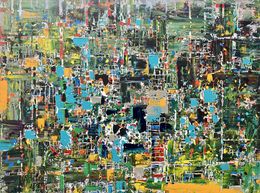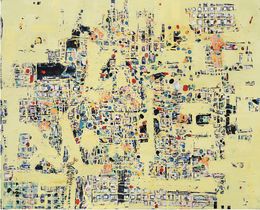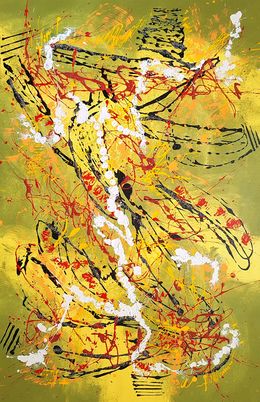Query
Category Painting
Artist Stanislav Bojankov Alex Senchenko Muriel Deumie Newel Hunter Gina Vor Nestor Toro Max Yaskin Nadine Antoniuk Nikolaos Schizas H-Nguyen Kris Haas Yichao Sun Gaëlle Wagner Daniela Pasqualini Rita Vandenherrewegen VeraD Jérémie Rebourgeard Larissa Uvarova Pascale Morelot-Palu Jean-Claude Bossel Tiny de Bruin Damien Berrard Thomas Jeunet Eric Robin Greet Helsen Gérard Pairé Laura Newman Eliana Sá Tracey Adams Volker Mayr Isa-L Aloyzas Smilingis Lia Van Leeuwen Rafael Sliks Morko Cosmos Allias Filip Pavlik Tic Sophie Mangelsen Luc Villard Benjamin Vitrol Vautier Alvarez Philippe Hautenauve Sandra Szaja Juliana Haggoo Hugo Isaac Marta Zawadzka Marco Saporiti Paulo Gnecco Tatiana Blanqué Gabriela Lavezzari Ovidiu Kloska Victoria Horkan Sylvie Adaoust Patrick Salamone Jo Sada Marcel Speet Blandine Insler Geo Hizny Sophie Qin Kyung-Ae Hur Dario Berterreche Ilja Freer Michèle Laurence Prévost John3seven Pasturo Bonus Bust the drip Shirley Goldfarb Giovanni. D Caroline Vis Stephanie Rivet Said Ouarzaz Molok Kareem Bonus Antoni Amat David Gua Paul Ygartua Milo Jean François Guelfi Riccardo di Cosmo Emilio Vedova Violeta Endo
Color Yellow Sky blue Dark blue Red Black Green Pink orange White Grey Navy blue Purple Beige brown golden Silver
Orientation Portrait Landscape Square
Medium acrylic oil mixed media aerosol paint canvas ink collage pastel paper oil stick watercolour Pigments Posca Knife Painting marker digital art gold leaf Indian ink Textiles enamel resin charcoal gold encaustic painting airbrush painting silver leaf tempera chalk lacquer Water glass sand pencil metal plastic pigment ink gouache linocut plaster concrete wood fashion accessory Butterfly tinted varnish paper mache lead mine digital print natural pigment print mosaic engraving glue Confetti Digital Painting cardboard wax vegetal foam plexiglass wool Tables jewelry Stencil feathers cotton Organic materials dyes walnut stain Watercolor ink fur
Theme Abstract artworks Landscape Street art Minimalism Floral Pop Art Portrait Seascape Figurative Geometric Music Eastern Art Conceptual Animal Nude Art brut Urban Landscape Garden Still Life Mountain landscapes Graphic Architecture Fantastic Everyday life Icons Black and white Vehicles Cinema African artworks Sport Fashion From the sky Comics Under Water Aboriginal art Vanity
Support canvas paper wood cardboard Fine art paper plexiglass Canson paper board cardboard + canvas Arches paper Wood aluminium Linen Hahnemuehle fine art paper Dibond textile plastic Fabriano paper polyester canvas watercolor paper paper mounted on canvas cotton paper handmade paper Plexiglas box burlap argentic paper polypropylène steel mirror papyrus found Object Evolon MDF
Thematic The Best of our British Galleries At home with Chairish Inspired by Pollock Autumn Collection Mid-Century Modern Interior A Natural Interior Works Inspired by the Four Elements Unusual Supports Inspired by Van Gogh Bright and Vivid Colors Impasto Art Picks for Less Than $500 Space-Inspired Artworks Springtime Tropical Touch French Street Artists Minimalist Interior Inspired by Zao Wou-Ki Inspired by Christian Awe Ready-to-Hang Artworks Winter Selection Inspired by Rothko Graphic Arts Scandinavian Minimalism Industrial Interior Asian-Inspired Interior Inspired by Miró Abstract Op Art Inspired by Pointillism Optical Illusions The Spirit of the Seventies After Dark A Pop Art Interior Images of the West Coast Art Picks by Interior Designers Fashion-Inspired Works Mood: Mysterious Inspired by Graphic Design Mood: Calm All That Glitters Inspired by Basquiat Inspired by Pop Art Inspired by Monet Cozy Chalet Interior Inspired by Damien Hirst Pastel The Art of Celebration States of Matter Pastel Colors Inspired by Frida Kahlo Mediterranean Interior The Rush of the City Inspired by Franz Kline The Garden Party Inspired by Sonia and Robert Delaunay Inspired by Naturalism Art Picks for Less Than $100 Depictions of the American South Dansaekhwa-inspired works Mood: Meditative Inspired by Yayoi Kusama Pantone Color of the Year 2023 Mood: Celebratory Summer Holidays Pattern Play Happy New Year Love in Art Light Games African Art Warm Colors Inspired by Mondrian Typography in Art Vintage Interior Inspired by Cézanne Vamos a la Playa Hyperrealism Interior Design Art Déco Interior Art for Your Living Room Bath Time Utopia Frieze Los Angeles Inspired by Giorgione Children in Art Inspired by Byzantine Crush of the Month: Our Team's Favorites in June Images of New England Inspired by William Turner Inspired by Sci-fi Crush of the Month: November Perfect Pieces for a Gallery Wall At home with PAMONO A Mix of Textures Gallerist Gift Guide 24 Artists to Watch in 2024
Tag Abstract art Colors Abstract expressionism colorful Expressionism Semi-abstract Abstract Minimalism Action painting Impressionism Lines Pattern Composition Autumn Jackson Pollock Graffiti Trees Landscape Sea Summer Triptych Artworks Circle Calligraphy Sky Women Urban art Diptych Artworks Jazz Geometric abstraction Sunrise Pointillism China Sunset Horizon Impasto Human body Crumpled paper Spring Blue Grass Psychedelic Heart Mountains Sun Plants Imaginary landscape City Polyptych Material Asia Movement Cubism Monochrome Explosion Meadow Fields Butterflies Asian art Skyscrapers Love Clouds Dream Winter Faces Bouquet Forest Men Birds Buildings Ocean Text Lake New York Silhouette Pond Illusion Beach Skyline Surrealism Heat Cosmos Figuration Pop Culture Realism Nature Aquatic Emoticon Fire Humans Jungle Color field painting Waves Hyperrealism Marilyn Monroe Mondrian Wall Sexuality Tuscany Fictional Character Wild animals Art deco
Price
Size Medium (< 115 x 115 cm) Large format Small (< 50 x 50 cm) Very small (< 25 x 25 cm) Very large (> 200 x 200 cm)
Selection Artworks by best-selling artists New & remarkable Artists Young Talents Our recommendations Special offers Master Artists
Movement Gestural abstraction Explosions of Color Post-Impressionism Abstract Japanese Art Spontaneous Lines Colorful Geometric Painters Process Art Naïve Artists Abstract Artists Working in Metallic Tones Abstract Street Art Abstract Explorations Abstract Figurative Sculpture Somber Abstract Painters Concrete Art De Stijl Deconstructivism Figurative Pop Artists South American Art Colorful Pop Sculptors Abstract Artists Working in Earthy Tones Emerging Asian Artists Fine line Human form Artworks Artists Working in Monochrome
Art fair
Height
Width
Page
Nationality French artists American artists Bulgarian artists British artists Swiss artists Ukrainian artists Thai artists Spanish artists Vietnamese artists Belgian artists Chinese artists Czech artists Dutch artists German artists Italian artists Portuguese artists Argentinean artists Lithuanian artists Brazilian artists Polish artists Romanian artists South Korean artists Canadian artists Moroccan artists Georgian artists
Sort
Universe






